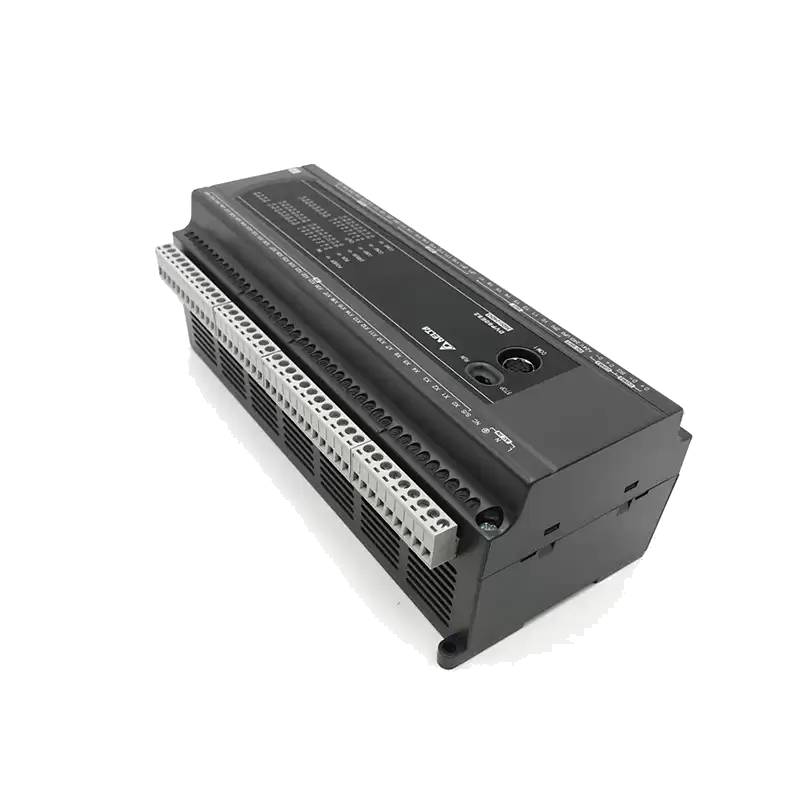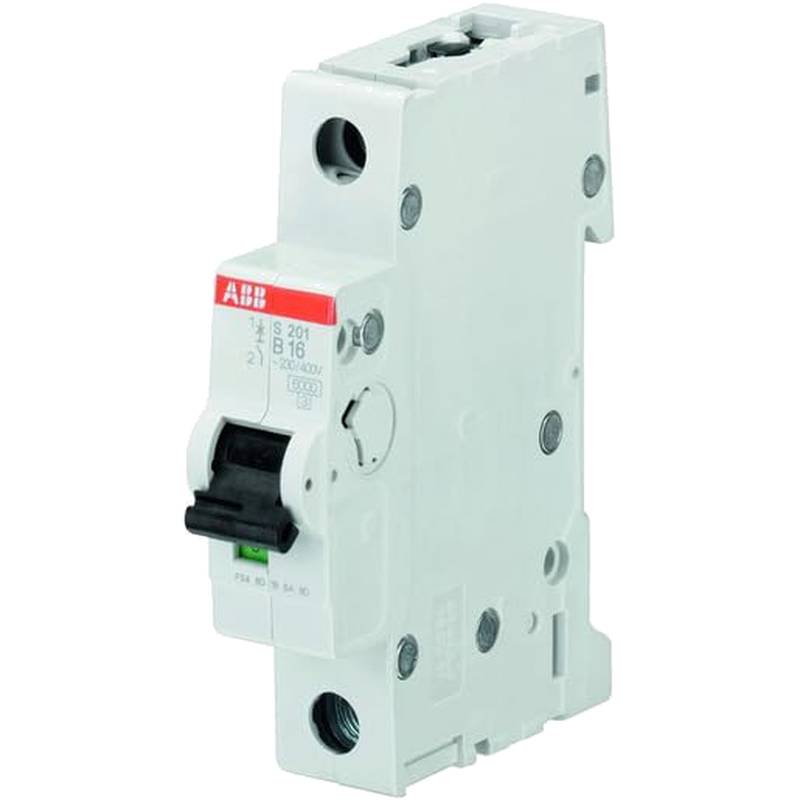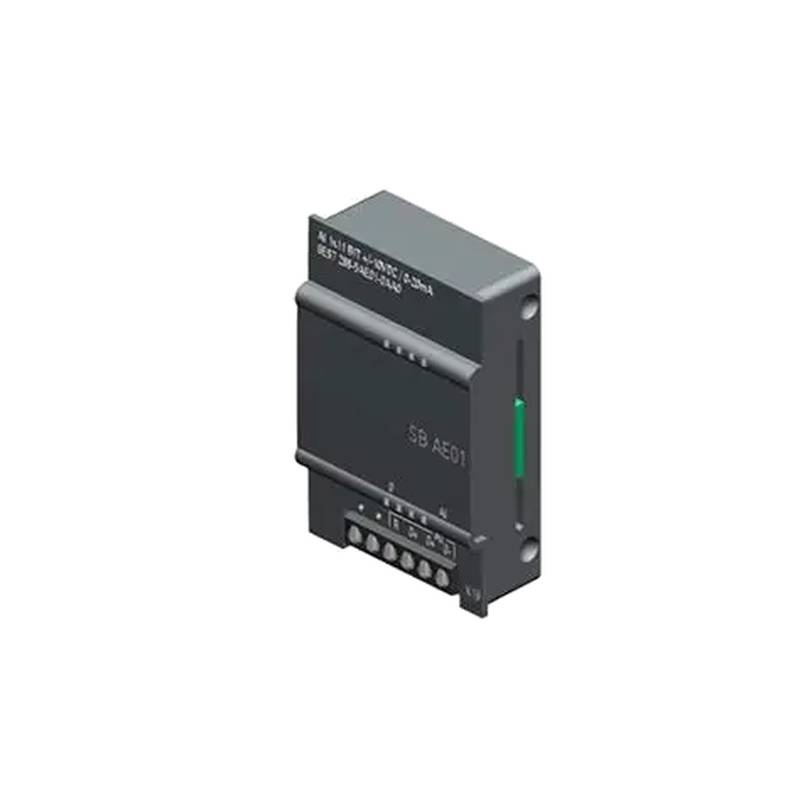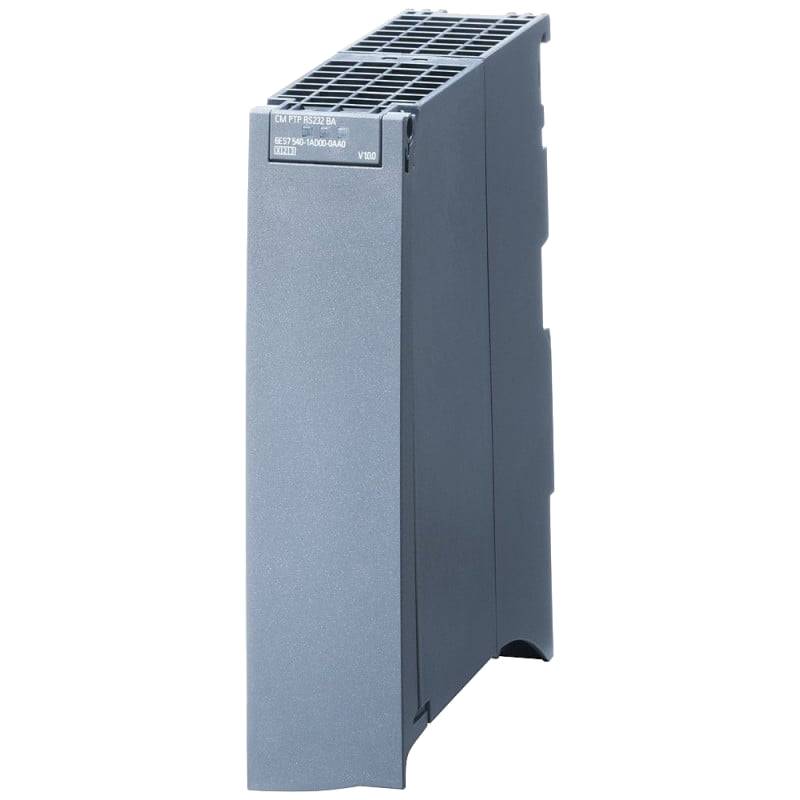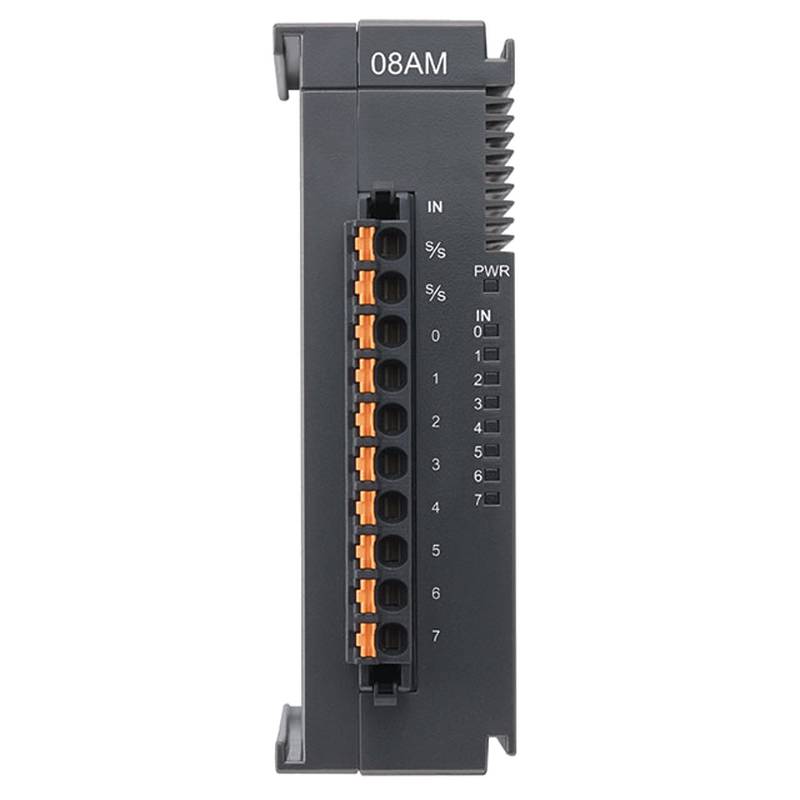
# Delta DVP60ES200TE: The 60-Point Intelligent Transistor Output Control Platform
The Delta DVP60ES200TE is a robust and versatile 60-point PLC designed for sophisticated industrial automation tasks. This intelligent control platform offers a high-speed 32-bit CPU, enabling rapid processing with an execution speed of 0.35 μs per basic instruction. It boasts 36 digital inputs and 24 transistor outputs, providing ample connectivity for diverse applications. The unit operates on a wide AC power supply range of 100-240VAC and features a program capacity of 16k steps with a data register capacity of 10k words. Its compact design and integrated communication capabilities, including built-in RS-232 and RS-485 ports, make it a powerful solution for various control system needs.
Product Specifications
| Specification | Value |
| :-------------------------- | :-------------------------------------------------------- |
| Model | DVP60ES200TE |
| Series | DVP-ES2 |
| Power Supply | 100 ~ 240VAC (50/60Hz) |
| Number of Digital Inputs | 36 |
| Number of Digital Outputs | 24 (Transistor Output) |
| Output Type | Transistor (NPN) |
| Program Capacity | 16k Steps |
| Data Register | 10k Words |
| Execution Speed (Basic Instruction) | 0.35 μs |
| Communication Ports | 1 x RS-232, 2 x RS-485 |
| Input Signal Voltage | 24VDC ±10% |
| Power Consumption | 30VA |
| Operating Temperature | 0°C to 55°C |
| Fuse Capacity | 2A/250VAC |
| Dimensions (H x D) | 225mm x 78mm (approximate, based on similar models) |
| Mounting | DIN rail |
Core Features & Market Positioning
The Delta DVP60ES200TE distinguishes itself in the competitive PLC market through its balance of performance, functionality, and cost-effectiveness. Its 32-bit CPU and 0.35 μs instruction execution speed provide the processing power needed for complex logic and high-speed operations, outperforming many comparable PLCs in its class. The inclusion of three built-in communication ports (1 RS-232 and 2 RS-485) facilitates seamless integration into various industrial networks and SCADA systems. This connectivity, combined with its 16k step program capacity, positions the DVP60ES200TE as a versatile controller suitable for both standalone applications and integration into larger automation architectures. Delta's commitment to user-friendly programming software, such as WPLSoft, further enhances its appeal, making it accessible for a wide range of engineers and technicians.
Key Application Scenarios
The Delta DVP60ES200TE is exceptionally well-suited for a variety of industrial automation tasks. Its robust input/output count and high-speed processing capabilities make it ideal for controlling complex machinery and processes. Common applications include:
Manufacturing and Assembly Lines: Managing sequential operations, controlling conveyor systems, and integrating with robotic components. Process Control: Automating batch processes, managing temperature, pressure, and flow rates in chemical, food and beverage, and water treatment plants. Material Handling: Optimizing the flow of goods in warehouses and distribution centers, controlling automated storage and retrieval systems (AS/RS). Packaging Machinery: Coordinating intricate movements and timing for high-speed packaging and filling operations. Building Automation: Controlling HVAC systems, lighting, and security in commercial and industrial facilities.
The transistor output configuration is particularly advantageous for applications requiring fast switching times and low power consumption, such as driving solid-state relays or interfacing with sensitive electronic components.
Practical System Integration Guidance
Integrating the Delta DVP60ES200TE into an existing or new system is streamlined by its design and Delta's comprehensive support ecosystem.
Wiring Considerations: Proper wiring is crucial for reliable operation and safety. Users must ensure correct connection of power supply, input signals, and output loads. For AC power input (100-240VAC), it's essential to adhere to local electrical codes and use appropriate circuit protection, such as a 3A fuse, as recommended for the DVP-ES series. For digital inputs, a 24VDC ±10% signal voltage is required. Grounding is paramount; the diameter of the grounding wire should not be shorter than that of the power supply cable, and all PLCs should be properly grounded, especially when multiple units are in use. Communication wiring for RS-232 and RS-485 ports should follow standard protocols, ensuring correct pinouts to avoid communication failures.
Programming with WPLSoft: Delta's WPLSoft programming software provides an intuitive environment for developing ladder logic, function block diagrams, and other programming languages. Basic programming involves connecting the PLC to a PC via the serial port (RS-232) or an RS-485 to USB converter. Users create logic by selecting inputs (e.g., X0, X1), outputs (e.g., Y0), and internal relays (M registers) within the software interface. Compiling the program (Ctrl+F7) and then downloading it to the PLC initiates the control sequence. Online mode allows for real-time monitoring and debugging of the program's execution.
Operation and Risk Mitigation
Safe and efficient operation of the DVP60ES200TE requires adherence to best practices and understanding potential failure points.
Safety Precautions: Always ensure the power is disconnected before performing any wiring or maintenance. Avoid touching terminals when the power is on. The PLC is an open-type device and should be installed in an enclosure to protect it from dust, humidity, electrical shock hazards, and vibration. Proper grounding is essential to prevent electrical noise and ensure operator safety. Never connect AC main circuit power to any input/output terminals, as this will damage the PLC.
Troubleshooting Common Issues: No Power: Verify the AC input voltage is within the specified range (100-240VAC). Check fuses and power supply connections. Communication Errors: Ensure correct wiring between the PLC and the programming device/HMI. Verify communication settings (baud rate, parity, stop bits) in both the PLC program and the communication software match. Check the RS-232 and RS-485 ports for physical damage. Incorrect Output: Confirm the logic in the program is executing as intended. Check if the output transistors are receiving the correct voltage and are not damaged. Verify that the output load does not exceed the rated current for the transistor outputs (typically 2A per point for similar ES2 models). Input Not Registering: Verify that input wiring is correct and the input voltage (24VDC) is applied. Check for damaged input points or field devices.
Fault Codes: While specific fault code lists are detailed in the comprehensive operation manuals, common issues might manifest through status LEDs on the PLC. Referencing the official Delta DVP-ES2 Operation Manual provides detailed diagnostic information.
Scalability & Long-Term Value
The Delta DVP60ES200TE offers significant scalability and long-term value, making it a strategic investment for evolving industrial needs.
Expansion Capabilities: While the DVP60ES200TE is a 60-point base unit, the DVP-ES2 series supports expansion modules, allowing for an increase in I/O count as demands grow. This modularity ensures that systems can be upgraded without replacing the entire PLC. The DVP-ES2 series itself is part of a broader Delta PLC ecosystem, offering compatibility with various communication modules and specialized units, such as analog I/O or communication interface modules.
Integration with IIoT and Digital Solutions: The built-in RS-485 ports support industrial communication protocols like Modbus RTU, enabling easy integration with SCADA systems, HMIs, and other IIoT-enabled platforms. This connectivity allows for remote monitoring, data logging, and advanced analytics, crucial for modern smart manufacturing initiatives. Delta's software suite, including ISPSoft and WPLSoft, supports the development of integrated solutions, making it easier to incorporate the DVP60ES200TE into Industry 4.0 strategies. The ability to connect to networks via Modbus TCP/IP and EtherNet/IP (on Ethernet-enabled models) further enhances its digital integration capabilities.
---
Frequently Asked Questions (FAQs)
1. What are the primary advantages of the Delta DVP60ES200TE PLC?
The Delta DVP60ES200TE offers a high-speed 32-bit CPU for rapid processing. It features a substantial 36 digital inputs and 24 transistor outputs. The PLC includes three communication ports (RS-232/RS-485) for flexible connectivity.
Its compact design and robust feature set make it cost-effective for demanding applications. The transistor output type is suitable for high-frequency switching tasks.
Delta's user-friendly WPLSoft programming software simplifies development and maintenance. The PLC also benefits from strong technical support and a broad ecosystem of compatible modules.
2. How do I connect the Delta DVP60ES200TE to a PC for programming?
Typically, you will use a programming cable (RS-232 or USB converter) to connect your PC to the PLC's communication port. Delta's WPLSoft software is used for programming.
Ensure you have the correct COM port selected in WPLSoft and that the PLC's communication settings (baud rate, parity) match. A common method involves using an RS-232 to USB adapter if your PC lacks a serial port.
Refer to the Delta PLC programming manual for specific cable diagrams and software configuration steps. Verify the physical connection and communication parameters before attempting to download or upload programs.
3. What type of output does the DVP60ES200TE have?
The DVP60ES200TE features 24 digital outputs of the transistor type. Specifically, these are typically NPN transistor outputs, suitable for sinking current.
Transistor outputs are ideal for high-speed switching applications, driving inductive loads like solenoids, and interfacing with other electronic circuits that require fast response times. They offer longer life compared to relay outputs due to the absence of mechanical contacts.
The maximum current rating for each transistor output is generally 2A, with specific voltage limits for AC and DC loads. Always consult the product datasheet for precise specifications on current and voltage handling capabilities.
4. Can the Delta DVP60ES200TE be expanded with additional I/O modules?
Yes, the DVP-ES2 series PLCs, including the DVP60ES200TE, support expansion modules. This allows you to increase the number of digital or analog inputs and outputs as needed.
Delta offers a range of expansion units that can be connected to the main PLC unit. These modules expand the system's capacity without requiring a complete PLC replacement.
Refer to the DVP-ES2 series documentation for a list of compatible expansion modules and instructions on how to connect and configure them. This modularity ensures long-term scalability for your automation projects.
5. What are the main communication protocols supported by this PLC?
The DVP60ES200TE comes with built-in RS-232 and RS-485 communication ports. These ports commonly support protocols such as Modbus RTU and ASCII for serial communication.
The RS-485 port, in particular, is well-suited for multi-drop configurations, allowing multiple devices to communicate on the same bus. This facilitates integration with HMIs, SCADA systems, and other industrial devices.
While this specific model may not have built-in Ethernet, other models in the DVP series (or with add-on modules) can support protocols like Modbus TCP/IP and EtherNet/IP for network connectivity.
6. What is the program capacity and data register size?
The Delta DVP60ES200TE has a program capacity of 16k steps. This provides ample space for complex control logic and sequences.
It also features a data register size of 10k words. These registers are used for storing variables, intermediate results, and other data required during program execution.
The combination of a generous program capacity and data register size allows for sophisticated automation tasks and data handling within the PLC's memory.
7. What is the operating temperature range for the DVP60ES200TE?
The Delta DVP60ES200TE is designed to operate within an industrial temperature range of 0°C to 55°C. This ensures reliable performance in many standard industrial environments.
For storage, the temperature range is broader, typically from -25°C to 70°C. This wider range helps protect the unit when it is not in operation or during shipping.
It is crucial to ensure the PLC is installed in an environment that falls within its specified operating temperature limits to prevent overheating or performance degradation. Proper ventilation within its enclosure is also important.
8. How does the execution speed of the DVP60ES200TE compare to other PLCs?
The DVP60ES200TE boasts a high-speed 32-bit CPU with an execution speed of 0.35 μs per basic instruction. This is considered very fast for a compact PLC in its class.
This rapid execution allows the PLC to handle demanding applications requiring quick responses, such as high-speed motion control, complex interlocking, or precise timing operations. It can process 1k steps of program within 1ms.
Compared to older or less powerful PLCs, this speed significantly enhances system responsiveness and efficiency, enabling more sophisticated control strategies.
9. What programming software is used for the Delta DVP60ES200TE?
The primary programming software for the Delta DVP60ES200TE and other DVP-ES2 series PLCs is WPLSoft. This free software supports ladder logic, instruction list, and other programming languages.
For newer Delta PLC series (like DVP-ES3), ISPSoft is the recommended programming environment. However, for the ES2 series, WPLSoft remains the standard and is widely used for development and configuration.
Users can download WPLSoft from Delta's official website. The software facilitates program creation, editing, compilation, debugging, and communication with the PLC.
10. Is the Delta DVP60ES200TE suitable for safety-critical applications?
While the Delta DVP60ES200TE is a capable and reliable PLC for general industrial automation, it is not typically certified for safety-critical applications that require SIL (Safety Integrity Level) ratings.
Safety-critical applications often demand specialized safety PLCs designed and certified to meet stringent international safety standards (e.g., IEC 61508). These PLCs incorporate hardware and software redundancy and specific safety functions.
For applications where failure could result in serious injury or significant damage, it is essential to use PLCs specifically designed and certified for safety functions, or to implement independent safety systems. Always consult relevant safety standards and regulations for your specific application.














